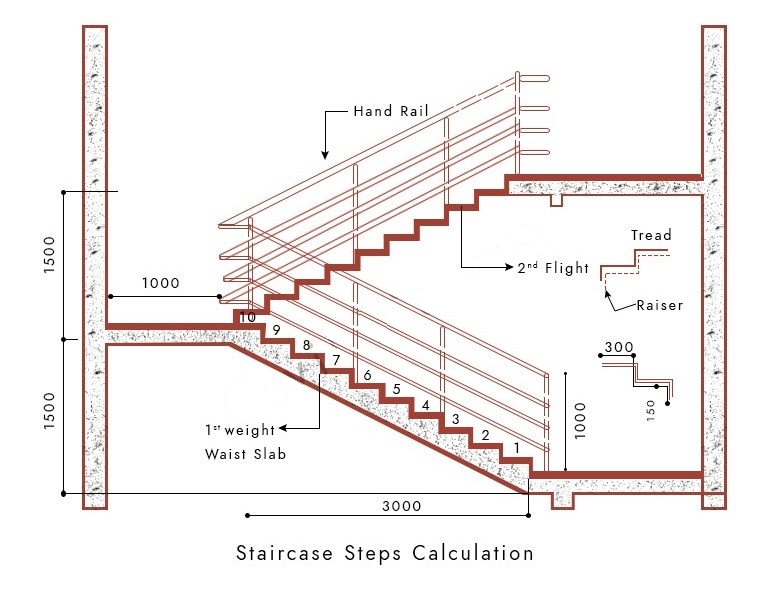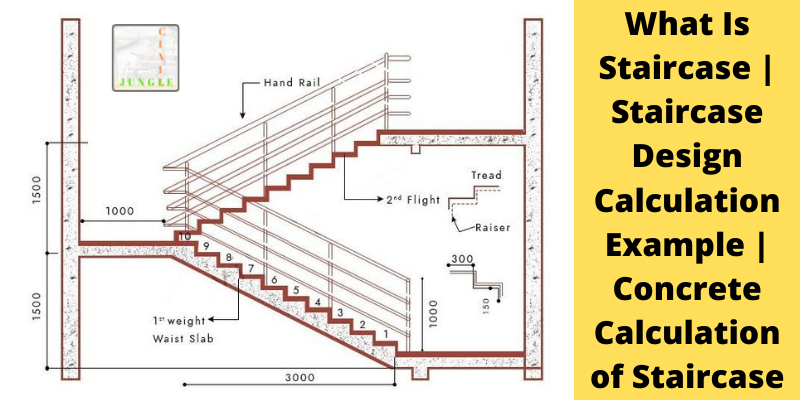What Is Staircase?
Important Point
Staircase, series, or flight, of steps between two floors. Traditionally, the staircase is a term for stairs accompanied by walls, but contemporary usage includes the stairs alone.
How to Calculate Number of Riser and Tread for a Staircase Steps?
Requirement of Staircase Calculation.
- Hight of Staircase.
- Length of Staircase.
- Maximum height of riser should be 150 mm (150 mm to 200 mm)
- Minimum tread length should be 300 mm (250 mm to 300 mm)
- Length of the step should be a minimum of 1000 mm
- Handrail height should be a minimum of 1000 mm.
- Width of the landing slab will be at least 1000 mm for the walkover on the staircase.
Also, read: Type of Stair | Stairs Parts Names & Details
Staircase Design Calculation Example
Now we are going to calculate the required number of Riser and Tread for a Dog legged staircase having
- 1 Meter Width of Landing Slab
- 3 Meter Height
- 4 Meter Width
- Middle Slab Highet 1.5 m

Staircase Dimension Calculation Formula
- Number of Tread = Length of Stair/One number of Tread
- Number of Riser = Height of Staircase/ Height of one number of Riser
From the above Diagram,
The staircase has divided into two flights providing a landing slab at mid of the staircase height.
- So Number of Riser = Height of Staircase / Height of one Rise
- Number of Riser = 1500/150
- Number of Riser = 10 Nos
- So as per standard, we are providing 300 mm as tread length.
- Number of Tread = Length of Stair/One number of Tread
- Number of Tread = 3000/300
- Number of Tread = 10 Nos
- Hence the required number of Riser and Tread is 10 Nos.
- Total No Staircase of = Below landing + Above landing
- Total No Staircase of = 10 Nos + 10 Nos = 20 Nos of Stire required to achieve 3 m hight
Also, read: How to Calculate Staircase | Concrete & Bar Bending Schedule (BBS) | Staircase Reinforcement Details
Concrete Calculation of Staircase
Section 1
- Landing area concrete = L x B x H
- Landing area concrete = 1.0 m. x 2.0 M. x 0.150 M.
- Landing area concrete = 0.3 Cu.m.——–(1)
Section 2
- Waist Slab Laenght = (a2+b2)= c2
- C = Lenght of Waist slab
- A = Hight of Landing Slab
- B = Breadth of Wasit slab
- Waist Slab Laenght = (1.52+3.02)= c2
- Waist Slab Laenght = c =√(11.25)
- Waist Slab Laenght = c =3.35 m
- Wasit slab area concrete = L x B x H x N
- Wasit slab area concrete = 3.35 m. x 1.5 m. x 0.150 m. x 2 Nos.
- Wasit slab area concrete = 1.501 Cu.m. ——–(2)
Section 3
- Steps area concrete = L x Volume of triangular area x N x Q
- Steps area concrete = 1.0 m. x ( 0.300 m. x 0.150 m x (1/2)) x 2 Nos. X 10 Qty
- Steps area concrete = 0. 45 Cu.m. ——–(3)
- Total Concrete of Staircase = (1) + (2) + (3)
- Total Concrete of Staircase = 0.30 Cu.m. + 1.501 Cu.m. + 0. 45 Cu.m.
- Total Concrete of Staircase = 2.251 Cu.m.
Staircase Design Calculation
- Calculate the number of steps that will be needed. Considering an ideal riser of 18 cm, the height of the space is divided by the height of each step.
- Calculate the height of each riser.
- Calculate the width of the tread.
Stair Tread Calculation
The vertical distance between the floors to be linked by the staircase is the principal determinant of the riser and tread dimensions. You divide the height by 7 inches; if, say, the floor-to-floor distance is 8 feet, 10 inches (or 106 inches), then you’ll need 15 treads (106 divided by 7 equals 15.14).
Standard Staircase Dimensions
The general rule (in the US) is 7-11 (a 7 inch rise and 11 inch run) (17.78cm-27.94cm). More exactly, no more than 7 3/4 inches (19.7cm) for the riser (vertical) and a minimum of 10 inches (25.4cm) for the tread (horizontal or step). You can find some more information here as well on other stair-related dimensions.
Stair Formulas
You divide the height by 7 inches; if, say, the floor-to-floor distance is 8 feet, 10 inches (or 106 inches), then you’ll need 15 treads (106 divided by 7 equals 15.14). Next, you divide the height by the number of treads (15 into 106), producing the exact tread height (7.06 inches).
Stair Stringers Formula
Start by figuring out how high the stairs will climb and how much space there will be between each step, or the intended “rise.” Divide the height by the approximate rise to determine the total number of steps needed, then take the difference of the height and that number to find the exact rise of each step.
Length of Staircase for 10 Foot Ceiling
The total length of a flight of stairs for a 10-foot ceiling is approximately 12-feet long.
Like this post? Share it with your friends!
Suggested Read –
- How to Structural Design a Building/House Step by Step Part-4 (Column Design)
- How to Structural Design a Building/House Step by Step Part-3 (Slab Beam Design)
- How to Structural Design a Building/House Step by Step Part-2 (Two Way Simply Support Slab)
- How to Structural Design a Building/House Step by Step Part-1 (One Way Simply Support Slab)
- What Is Septic Tank | How Does A Septic Tank Work | Septic Tank Design based Per User Consumption


Nice Article Dear
Thanks